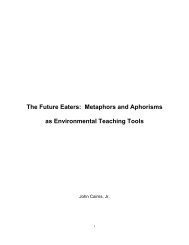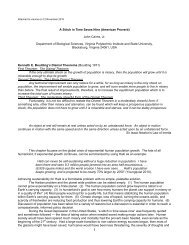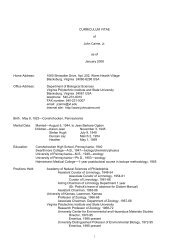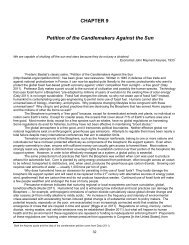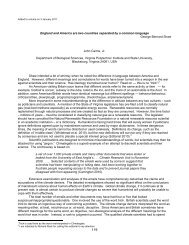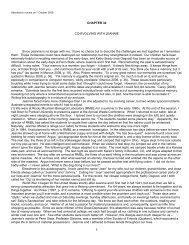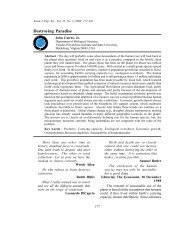266Cairns: Eco-Ethics and Sustainability Ethicsnotes, grain exports are, in reality, water exports, so food and water supplies are closely linked. TheUnited Nations (2001) has already called attention to the need to restore the balance betweenwater supply and human needs, which may depend on stabilizing population in water-deficit countries.Attempts to maintain the status quo on population increase and ever larger ecological footprintswill eventually cause an ecological catastrophe so horrendous that even a fool will see it. Thiscatastrophe can be avoided by shifting from exploitation of natural resources to sustainable use.Surprisingly, a major step in this regard can be taken at little cost to most of humankind.ELIMINATING PERVERSE SUBSIDIESMyers & Kent (1998) define perverse subsidies as subsides that exert adverse effects uponeconomies and environments alike. Total subsidies (both perverse and beneficial) are estimated tobe roughly US $2 trillion worldwide per year (e.g. Panayotou 1993; United Nations Commission onSustainable Development 1994). Many subsides, such as fostering overloading of croplands (e.g.erosion of topsoil), fossil fuel (e.g. air pollution, including greenhouse gases), road transportation(e.g. overuse of cars), water supply (e.g. overuse of water), fisheries (e.g. overharvesting), andforestry (e.g. excessive logging), are clearly perverse. Although this subject has been discussed(e.g. de Moor 1997; Roodman 1998), there is no general awareness of the extent to which subsidiesdamage the environment. From an eco-ethical standpoint, more numbers will not help answerthe basic question — is it ethical to create more ecological deficits for future generations to reduce?From an eco-centric viewpoint — is it ethical to use other species as commodities, especially whenthey collectively constitute humankind’s ecological life support system? In this case, the numbersare unambiguous — governments worldwide are subsidizing activities that harm the environmentand often the economy as well. The US has numerous special interest groups that penetrate thepolitical process. In the US capitol city, tens of thousands of lobbyists (as well as lawyers to keepthem informed about various laws, loopholes, or about drafting new laws) attempt to affect laws.Between 1993 and mid-1996, American oil and gas companies gave US $10.3 million to politicalcampaigns and received tax breaks worth US $4.0 billion. Meyer et al. (1992) report that depletionof soils, forests, and fisheries resulted in a 25-30 % reduction in potential economic growth. Thus,at best, subsidies may help produce a short-term economic gain but a long-term loss. This strategyis not the way to achieve sustainable use of the planet.KNOWLEDGE AND COMPLICITYIn July 2002, a jury of citizens in the State of Florida, US, found two Salvadoran generalsresponsible for torture of leftist insurgents. The charge against the officers was not that they torturedwith their own hands but that they knew about human rights abuses perpetuated by menthey commanded and did nothing to stop them. The sine qua non of international law andhuman rights abuses is that they must be universally applied — not just applied when theycoincide with policy goals. If this is true for human rights abuses, should it not also be true forenvironmental abuses? Complicity is a partnership or involvement in wrongdoing and is mostcommonly interpreted as harm to humans. However, degrading the planet’s ecological life supportsystem also harms humans, although a modest level of ecological literacy is required tomake this connection. Recently, I read an excellent ecology book intended for students in thefifth grade of school (approximately age 11). Surely it is not unreasonable to expect our leadersand the general public to have a grasp of ecology expected of students in the fifth grade. Eitherthey are ecologically illiterate or they have the knowledge to be aware of wrongdoing. If the latter
Article 30267is true, they are guilty of complicity; if the former is true, they are not sufficiently literate to beeither leaders or voters.In a democratic state, it is the electorate that is ultimately responsible for this regrettable situation.Responsible citizenship requires focused attention. Alertness is essential, even if some of thedetails are boring. Affluent modern society appears to have chosen entertainment and other activitiesthat diminish focused attention on environmental problems. Neil Postman (1986), in his bookAmusing Ourselves to Death, remarks that 19th century farmers in the US turned out for hours-longdebates between Abraham Lincoln (who subsequently became US President) and his opponentStephen Douglas. The villagers were hardworking people who put in long, hard hours at work, butit did not affect their sense of responsibility. In the US, irresponsible acts such as ‘road rage’ areincreasing. At the same time, voter turnout, financial support for education, retirement security,corporate accountability, and air quality are declining. This irresponsibility is not an appropriatecondition for the world’s only superpower, which one hopes would make sound decisions, especiallyon sustainability. Of course, sustainable use of the planet requires widespread ecological literacyand an informed citizenry in all the world’s nations.The present human population size and distribution is dependent upon both Earth’s ecologicallife support system, consisting of natural capital and the ecosystem services it provides, and atechnological/economic life support system. The metrics of the latter system are well known. Farless well known to elected and regulatory officials, as well as other decision makers, are the metricsof the ecological life support system. This system (the biosphere) operates at the global levelwith an array of subsystems of decreasing complexity, ranging from bioregions to ecosystems tocommunities to individual species. The type of decision being made will determine the specificmetrics that are appropriate (e.g. Cairns & Smith 1989; Cairns et al. 1993). Moreover, for sounddecision making at all levels of biological organization, the connections between the different levelsmust be made clear. 2Some illustrative metrics for ecosystem restoration are in National Research Council (1992) , Hoffmanet al. (2003), and Holl & Cairns (2003). Long-term effects, such as climate change, will requiretrend analysis. The metrics will provide an estimate of the condition of the ecological life support system,but the ultimate decision will be based on value judgments and ethics. Both the metrics and theethics will require critical judgment and the reasoning behind each decision should be explicitly stated.ASSESSING & COMMUNICATING NUMERACYIn order to verify complicity, one needs to determine numeracy about sustainability. Some illustrativequestions follow.Assessing numeracy1. What do leaders and the general public know about sustainability?2. What level of numeracy do they have about sustainability?3. What do government leaders and the general public think about these numbers?4. What information (numbers) about sustainability do leaders and the general publicunderstand?5. What numbers still cause confusion?2 Cairns J Jr (2003) Integrating top-down/bottom-up sustainability strategies: an ethical challenge. ESEP2003:1–6. Available at http://www.esep.de/articles/esep/2003/E26.pdf



